 The art of painting has been a
medium of both expression and communication from the earliest known period of
history. Man, as nomad, wandering in search of food and security, gradually
discovered a language of line and form for expressing his ideas; which account
for pre-historic paintings appearing in rock shelters. At a later period, this
found expression in the paintings on chalcolithic pottery discovered at various
centres. In India, the patterns were either geometric or were styled after the
flora and fauna and at times depicted human figures.
The art of painting has been a
medium of both expression and communication from the earliest known period of
history. Man, as nomad, wandering in search of food and security, gradually
discovered a language of line and form for expressing his ideas; which account
for pre-historic paintings appearing in rock shelters. At a later period, this
found expression in the paintings on chalcolithic pottery discovered at various
centres. In India, the patterns were either geometric or were styled after the
flora and fauna and at times depicted human figures.
The art of painting in India
progressed gradually and it reached its zenith during the Satavahana period (2nd
- 1st B.C.) and also the Gupta-Vakataka period (5th-6th
A.D.). Mainly of the Buddhist theme, the paintings were on the large canvas of
granite walls of the Ajanta caves. The style was line-oriented and natural,
besides being brilliant in colour. The painters drew inspiration from the
legends related to the previous incarnations of Buddha.
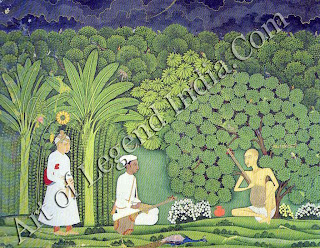
The pattern of large scale wall
painting which had dominated the scene, witnessed the advent of miniature
paintings during the 11th & 12th centuries. This new
style figured first in the form of illustrations etched on palm-leaf
manuscripts. The contents of these manuscripts included literature on the
Buddhism and Jainism. In eastern India, the principle centres of artistic and
intellectual activities of the Buddhist religion were Nalanda, Odantapuri,
Vikramshila and Somarupa situated in the Pala kingdom (Bengal and Bihar).
Buddhist works like the Ashtasahasrika-Prajnaparamita, the Mahamayuri and the
Pancharaksha are few examples to cite, which were illustrated with Buddhist
deities in late Ajanta style. In western India, however, it was the Jain faith
which dominated, Rajasthan, Gujarat. and Malwa being the principle centres of
Jain religion and art. Apart from the Kalkacharya Katha and the Kalpasutra, two
well-known Jain treatises, Hindu themes such as the Balagopal Stuti as well as
secular works like the Vasanta Vilas found expression on palm-leaf
illustrations and came be known as the Jain or Western Indian Style of
painting.
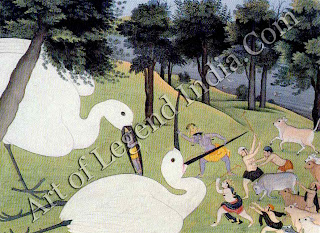 The Jain Style is unique as it
bears an exaggerated linear quality. Facial outlines are emphasized, the nose
is long and sharp, and the eyes are shaped like petals with the farther eye
projected beyond the outline of the face. The backgrounds are illuminated in
shades of dark blue, red and green or yellow. Gold is used for decorative
purpose, especially in the manuscripts of a later era, which were done on
paper, a medium, that had replaced the palm-leaf.
The Jain Style is unique as it
bears an exaggerated linear quality. Facial outlines are emphasized, the nose
is long and sharp, and the eyes are shaped like petals with the farther eye
projected beyond the outline of the face. The backgrounds are illuminated in
shades of dark blue, red and green or yellow. Gold is used for decorative
purpose, especially in the manuscripts of a later era, which were done on
paper, a medium, that had replaced the palm-leaf.
In these the compositional
format is confined to figures or objects generally arranged in horizontal
bands.
It was in the 14th century
A.D. that paper replaced the palm-leaf. The Jain Style of paintings attained a
high degree of development by the late 15th and early 16th century.
A new trend in manuscript illustration was set by a manuscript of the Nimatnama
painted at Mandu, during the reign of Nasir Shah (1500-1510 A.D.). This
represented a synthesis of the indigenous and the Persian Style, though it was
the latter which dominated the Mandu manuscripts. There was another style of
painting known as Lodi Khuladar that flourished in the Sultanate's dominion of
North India extending from Delhi to Jaunpur during the late 15th and early 16th
century. The best known example of the Lodi Style is the famous Aranyaka Parvan
belonging to the Asiatic Society, Bombay painted in 1516 A.D. during the
victorious reign of Sikandar Shah Lodi at Kachuvava, about 57 miles away from
Agra. Fine specimens of paintings in jaur Style can be seen in the well-known
manuscripts such as the Chaura Panchashika and the Gita-Govinda. This style is
marked by the ornaments adorning the women and their pendulous breasts, besides
the chequered designs of their garments. The figures have large eyes and
exaggerated profiles. Though emanating from the Jain Style of Delhi and
Jaunpur, this form has striking characteristics of its own.
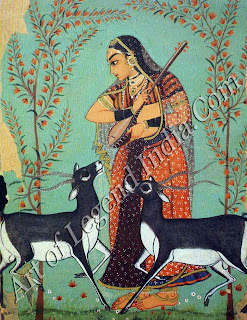
Akbar's reign (1556-1605)
ushered a new era in Indian miniature painting. He was the first monarch who established
in India an atelier under the supervision of two Persian master-artists, Mir
Sayyed Ali and Abdul-ul-Samad Khan. Earlier, both of them had served under the
patronage of Humayun in Kabul and accompanied him to India when he regained his
throne in 1555. Later, a number of artists were engaged to work under their
guidance to decorate Akbar's imperial studio at Fatehpur Sikri. One of the
first productions of that school of painting was the Hamzanama series, which,
according to the court historian, Badayuni, was started in 1567 and completed
in 1582. It is interesting to note that most of the artists belonged to the
Hindu communities hailing from Gujarat, Gwalior and Kashmir, who gave birth to
a new school of painting, popularly known as the Mughal School of Painting.
This synthesis of the Saffavid School and the indigenous kalams of miniature
art owe a debt to the secular outlook of Akbar. And it proved to be a landmark
in the history of Indian miniature painting. Akbar commissioned a large number
of manuscripts, illustrated in this style, for his Imperial Library. However,
this style of painting reached its zenith during the reigns of Jahangir
(1605-1627) and Shah Jahan (1628-1658), but declined rapidly during the years
that followed under the rule of Aurangzeb (1658-1707).
The earliest known manuscript
illustrated in this fashion during Akbar's regime is the
Duwal-Rani-Khizar-Ichani: Written by the celebrated poet Amir Khusro, the
illustrations are attributed to Mir Sayyed Ali, the master-painter, who
undertook the work in 1568. The paintings of the liamzanama which represented
the most ambitious project undertaken during the golden era of Akbar, were
executed on large canvas made of cotton cloth. Initially, the work was started
by about 30 artists, but their number grew to more than a hundred at the time
of its completion. The work on these illustrations served as an excellent
training ground for the painters of the royal atelier. The style of Mughal
paintings is distinguished by the dramatic action and bold brush work. Apart
from the Hamzanama, many other manuscripts such as the Razmanama, the
Baburnama, the Akbarnama etc., were also illustrated in similar vein.

It was in the last quarter of
the 16th century that European influence began to affect the Mughal School.
Hence, a number of Christian themes were also painted by the Mughal artists.
Jahangir was an enthusiastic patron of the arts. He possessed an innate quality
for the appreciation of painting and talent for observing the nature keenly. Whenever
he came across an unusual plant or bird or animal, he instructed his artists to
paint them. Particularly, Mansur, one of the most talented painters excelled in
animal and bird motifs. The art of painting attracted and charmed Jahangir so
much that his period is remarkable for beautiful illustrations of several
manuscripts. Jahangir's period is characterised by naturalism, both in colour
and form. During Shah Jahan's reign (1628-1658), the Mughal artists' favorite
themes for paintings were emperors and princes visiting Sufi saints. In
addition, court scenes, portraits and studies of birds and animals continued to
be depicted.
The fine quality of the Mughal
painting was sustained during the period of Shah Jahan, even though he paid
greater attention to architecture. The high quality work of the earlier reigns
did not survive during the period of Aurangzeb, although some good portraiture
and hunting scenes were executed in his time. Being an orthodox Muslim, he did
not encourage the art of painting. However, in the reigns of Farrukhsyiar
(1713-1719) and Muhammed Shah (1719-1748), the art of miniatnre painting was
revived again. A known romantic as Muhammad Shah was, love scenes and romantic
subjects began to feature frequently, which seemed to rebound on Aurangzeb's
puritanical attitude.
 The era of Mughal painting came
to an end during the period of Shah A lam (1759-1806) when the Mughal empire
was virtually confined to an area enclosed by the walls of the Red Fort in
Delhi.
The era of Mughal painting came
to an end during the period of Shah A lam (1759-1806) when the Mughal empire
was virtually confined to an area enclosed by the walls of the Red Fort in
Delhi.
The style of paintings in the
provincial cities of the Mughal empire such as Murshidabad, Faizabad, Lucknow
and Patna has been described as Provincial Mughal. The Mughal Governors of
these provinces had assumed independent status following the decline of Mughal
empire during the middle of the 18th century. There were no drastic changes in
the Provincial Mughal Style of painting, but it has certain recognisable
features of its own. Mir Chand was one of the best known artists of this period.
Other provincial artists sought to imitate earlier work to suit the varying
tastes of their patrons rather than evolving distinctive styles of their own.
As for the Deccani painting,
initially it was a product of the Sheraz Style of Persian painting and the
local art forms of the Hindu kingdom of Vijayanagar; Later, it was influenced
by the Mughal Style during the late 17th and 18th century. The earliest
surviving examples of Deccan; painting go back to circa A.D. 1565-1567 and are
now scattered in many collections belonging to A hmadnagar and Bijapur Schools.
A school of Deccani painting also flourished at Golconda, the style of which is
remarkably consistent in quality and is a combination of a high degree of
technical excellence with refinement of line and a subtle richness in its
colour palette.
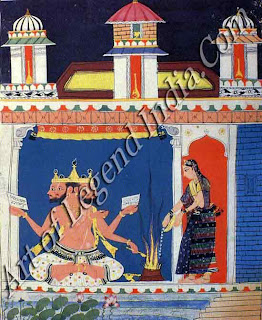 The Bijapur School of painting
was patronized and developed under the powerful king Ali Adil Shah I(1558-1580)
and his successor, Ibrahim Adil Shah I (1580-1627), a great lover of art. An
illustrated manuscript of the Nujum-ul-ulum, a book on astronomy which was
painted at Bijapur during 1580, is the most notable work of the early Bijapur
School. Prior to this, the Tarif-i-Husain Shahi manuscript was written and
illustrated at A hmadnagar during 1565-1567. The Golconda School commenced
under Ibrahim in the middle of the 17th century and continued till the period
of A bdullah Qutub Shah (1626-1672) and last Golconda ruler Tana Shah
(1672-1687). The style of this school was distinguished by rich colours,
considerable use of gold and the frequent use of unusual architectural forms.
The art of painting in the Deccan continued till late 18th century but it
became increasingly decorative. However, there are some fine sets of the
Ragamala, which were painted during 1725-1778.
The Bijapur School of painting
was patronized and developed under the powerful king Ali Adil Shah I(1558-1580)
and his successor, Ibrahim Adil Shah I (1580-1627), a great lover of art. An
illustrated manuscript of the Nujum-ul-ulum, a book on astronomy which was
painted at Bijapur during 1580, is the most notable work of the early Bijapur
School. Prior to this, the Tarif-i-Husain Shahi manuscript was written and
illustrated at A hmadnagar during 1565-1567. The Golconda School commenced
under Ibrahim in the middle of the 17th century and continued till the period
of A bdullah Qutub Shah (1626-1672) and last Golconda ruler Tana Shah
(1672-1687). The style of this school was distinguished by rich colours,
considerable use of gold and the frequent use of unusual architectural forms.
The art of painting in the Deccan continued till late 18th century but it
became increasingly decorative. However, there are some fine sets of the
Ragamala, which were painted during 1725-1778.
Rajasthani paintings covered a
wide area including Malwa, Bundelkhand, Mewar, Bundi, Kota, Jaipur, Bikaner, Si
rohi, Sawar, Kishangarh and Marwar. What is interesting to note is that each
centre developed its own individual characteristics. In Rajputana, painting was
already in vogue in the form of Western Indian or Jain Style. This had provided
a base for the growth of various schools of painting under the influence of
popular Mughal School from circa 1590-1600. Nevertheless, the Rajasthani
kalanis developed their own styles in the years that followed.
The earliest available set of
Rajasthani painting is the Ragamala done by a Muslim artist, Nissardin, in 1605
at Chawand in Mewar. Yet another Ragamala in the Mewar Style was painted by the
artist Sahibdin in 1628. Sahibdin's work greatly influenced the development of
early Rajasthani painting in Mewar. He became the principle artist of the Mewar
court during the reign of jagat Singh I (1628-1652).
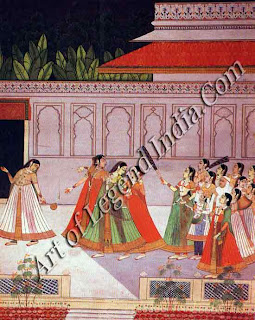 The rise of Vaisnavism and the
Bhakti cult in Rajasthan exercised a marked influence both on literature and
pictorial art. Krishna became the 'supreme god, while Radha was considered as
the symbol of divine love.
The rise of Vaisnavism and the
Bhakti cult in Rajasthan exercised a marked influence both on literature and
pictorial art. Krishna became the 'supreme god, while Radha was considered as
the symbol of divine love.
Most of the themes in art and
literature revolved largely around them. The famous literary and poetic works
such as the Gita-Govinda written by the court poet Jay Deva who lived in Bengal
in the 12th century; the Rasikapriya by Kesava Das of Orcha (1555-1617); the
Amaru Shataka, the hundred love lyrics by Amaru; Bihari's Satsai (circa
1603-1663), the classification of its heroes and heroines theme, better known
as the Nayika Bheda, were repeatedly illustrated with these forms. Apart from
mythological stories, the Devi Purana, the Bhagavata Purana, the Ramayana, the
Mahabharata, the Ragamala, the Baramasa and the activities of daily life were
extensively painted.
One striking feature of
Rajasthani painting is the arrangement of figures as even small figures are not
obscured in the composition. The background, the flora and fauna and the
symbols help the composition to express an intensity of feelings and emotions.
Architecture usually painted in the background, is used as a device to create
perspective and depth. Faces are often modelled with a tinge of colour to
impart a certain roundness to them. In the 18th century, the names of rulers,
artists and even dates and titles sometimes appear on the upper margin of the
paintings. Foremost amongst the Rajasthani schools are those of Mewar, Malwa,
Jaipur, Jodhpur, Nagaur, Sirohi, Kota, Bunch, Bikaner and Kishangarh, while
many thikanas (feudal baronies) such as Deogarh, Ghanerao, Malpura, Pali etc.
also had painters at their own courts.
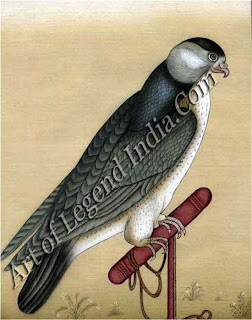
The Malwa Style is marked by
bold and strong colours. Figures with long wide eyes are usually projected
against monochrome backgrounds of varying rich tonalities. The composition are
very simple and the picture space is often divided into compartments in order
to separate one scene from the other. An important series of paintings in the
Malwa Style is a Rasikapriya dated 1634, which was certainly painted in Orcha.
There are also illustrations in the Ramayana and the Bhagavata Purana and there
are good reasons to believe that they were painted about 1642-1645 for the
queen, Hira Rani, wife of Pahar Singh of Orcha. An Amaru Shataka series was
painted in circa 1652 at Nasaratgarh near Mandu, while a Ragamala series (now
in the National Museum) was painted at Narsinghagarh by an artist named Madhav
Das.
Paintings from Mewar assume a
great variety for the use of a wide range of colours such as saffron, yellow,
ochre, navy blue, brown, crimson, etc. The backgrounds usually have stylised
architecture consisting of domed pavilions and small turrets. The treatment of
trees is only partially naturalistic, and the foregrounds are decorated with
flowers and birds. The menfolk sport a janza, a long garment which is both
plain and fuliskirted. A scarf is worn over one shoulder and sometimes around
the waist as well. The turban is either loosely wound or has a band tied
tightly around it.
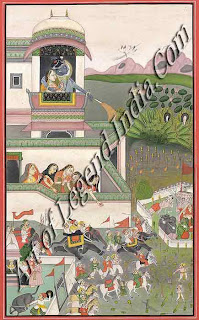 Marwar was an important centre
of Gujarati-Jain art activities. It was at Marwar and other places such as
Jodhpur, Pali and Nagaur that a variety of sub-schools of painting developed
during 17th-19th centuries. Of these, Jodhpur is the most important centre of
the Marwar School of painting. The turban seen in Marwar painting has its own
characteristics. It is funnel-shaped and markedly high. The faces are usually
drawn in profile, and bright colours are preferred in the composition. Spiral
clouds are also shown streaming on the horizon. A large number of portraits,
court scenes and themes such as Baramasa are to be found in the Jodhpur Style.
Though paintings at Pali, a thikana, belonging to the Marwar School are
somewhat traditional, yet they are important to the art historians for there is
a dated Ragamala series of 1623 painted by an artist Viraji, several folios of
which are now in the National Museum. In Nagaur, another centre of the Marwar
School, we find among other subjects several important portraits executed in a
markedly dignified style.
Marwar was an important centre
of Gujarati-Jain art activities. It was at Marwar and other places such as
Jodhpur, Pali and Nagaur that a variety of sub-schools of painting developed
during 17th-19th centuries. Of these, Jodhpur is the most important centre of
the Marwar School of painting. The turban seen in Marwar painting has its own
characteristics. It is funnel-shaped and markedly high. The faces are usually
drawn in profile, and bright colours are preferred in the composition. Spiral
clouds are also shown streaming on the horizon. A large number of portraits,
court scenes and themes such as Baramasa are to be found in the Jodhpur Style.
Though paintings at Pali, a thikana, belonging to the Marwar School are
somewhat traditional, yet they are important to the art historians for there is
a dated Ragamala series of 1623 painted by an artist Viraji, several folios of
which are now in the National Museum. In Nagaur, another centre of the Marwar
School, we find among other subjects several important portraits executed in a
markedly dignified style.
Bikaner was one of the most
important states of Rajasthan. This state was established in the 15th century
by a chieftain named Bika. It was during the-middle of the 17th century that a
few artists from the Mughal School visited Bikaner and worked there under its
patronage. Ali Raza, an Ustad (master-painter) from Delhi was amongst them. The
names of some other well-known Bikaner artists are Ruknucidin and his son
Sahibdin, Isa, Mohammed Ibrahim and 'Alpha. Most of the Bikaner artists were
Muslim, and they worked in a style which although markedly Mughal in character,
had certain distinctive features of its own. The Bikaner Style is known for its
very fine draughtsmanship and subdued colour tonalities.
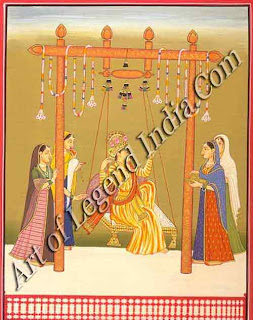
The Buildi School came into
existence during the early 17th century; an early influence was the popular
Mughal Style of a Ragamala series painted at Chunar near Banaras in 1591. An
example of the early Chunar series, Bhairon Ragini, is housed in the Allahabad
Museum and there are examples in other collections also. Originally mistaken as
a Bundi series, it is in fact a popular Mughal series which influenced the
early Bundi School for the Chunar series had come into the possession of a
family of Bundi-Kota artists sometimes about 1625-1630 and was used as a model
for painting scroll in Bundi and its sister state Kota. It was the influence of
the Chunar series that brought into existence the Bundi School. The Bundi
School was also influenced by the Deccan i painting to some extent. The Bundi artists
had their own standard in depicting feminine beauty: women are portrayted with
small round faces, receding foreheads, prominent noses and full cheeks, while
the female dress usually consists of a pyjama over which a transparent Jama is
worn. Another feature of the Bundi School is lush landscapes painted in vibrant
colours and massed with a variety of forms of trees and floral creepers, water
ponds with lotus flowers in the foreground, fish and birds. Sometimes a yellow
band appears on top of the painting with a text in Nagiri characters. Kota
state in the southern Rajasthan was separated from its sister state of Bundi in
1624.
The Kota School is so close to
the Bundi School that at times it is difficult to assert whether a painting is
of the Bundi or the Kota kalam. Though a distinctive Kota Style evolved in
mid-17th century, similarities between Bundi and Kota painting continued in
many respects with discernible variations in details, costumes and methods of
shading the faces. The Kota hunting scenes, depicting princes and nobles with
their retinue engaged in hunting lions
and tigers in the rocky and somewhat sparsely wooded forests of that region,
are now world famous.
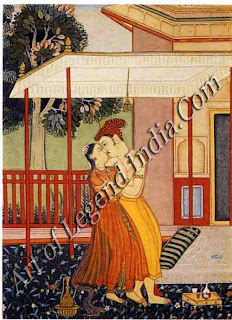 It was at Amber, the former
capital city of Rajasthan that the Jaipur School of painting originated. The
capital was shifted to the newly planned city of Jaipur only in 1728. The
rulers at Amber had maintained cordial relations with the Mughal emperors, and
this association left its impact on the artistic activities at Amber. Jaipur
paintings are plentiful and embrace a variety of subjects, but they neither
possess the subtler qualities as evidenced in the Bundi, Kota, Kishangarh or
Bikaner Schools nor bear the bolder qualities of Mewar and Marwar Schools of
Rajasthani painting.
It was at Amber, the former
capital city of Rajasthan that the Jaipur School of painting originated. The
capital was shifted to the newly planned city of Jaipur only in 1728. The
rulers at Amber had maintained cordial relations with the Mughal emperors, and
this association left its impact on the artistic activities at Amber. Jaipur
paintings are plentiful and embrace a variety of subjects, but they neither
possess the subtler qualities as evidenced in the Bundi, Kota, Kishangarh or
Bikaner Schools nor bear the bolder qualities of Mewar and Marwar Schools of
Rajasthani painting.
The state of Kishangarh was
founded by Kishan Singh, a younger brother of Raja Sur Singh of Jodhpur in
circa 1609. It was during the second quarter of the 18th century (1735-1748)
that some of the most charming pieces of Kishangarh painting were produced. Raja
Sawant Singh was on the throne during that period. A great patron of art and
literature as he was, he composed devotional songs in praise of Radha and
Krishna using the pseudonym of Nagari Das.
Kishangarh painting, at its
finest, is distinguished by its exquisite quality not to be found in other
Rajasthani schools and a distinctive type of female face with receding
forehead, arched eyebrows, lotus shaped eyes slightly tinged with pink, sharp
pointed nose, thin and sensitive lips and pointed chin. Nihal Chand was the
most important artist of Kishangarh, who is said to have worked there between
1735 - 1757 and probably even later. He executed beautiful portraits of Krishna
and Radha, the facial type for Radha being based on the exquisite countenance
of Sawant Singh's beloved mistress popularly known as Bani Thani. Krishna's
face in these paintings was also stylised to look somewhat similar, though as a
male countenance to the stylised face of Bani Thani. A statement made by some
writers that the stylised Kishangarh Radha was not based on the face of Bani
Thani is due to their ignorance of a tradition believed over two centuries by
well-known scholars of Hindi Brij Bhasa. In fact, there is a contemporary
painting of her approaching Sawant Singh who is performing Puja, and it is also
evident that the stylised Kishangarh Radha is based on the tall beautiful
figure and face of Bani Thani as seen in this painting. Those who opine that
these paintings are of a later date appear to be rather ignorant of the stylistic
features of Kishangarh paintings.
The art of miniature painting
in the Punjab hills known as Pahari painting was influenced to some extent by
the Mughal painting of Aurangzeb's period as well as paintings from Nepal,
probably via Kashmir, particularly in its stylised tree forms. Pahari paintings
had its beginning under Raja Kripal Pal of Basohli (1678-1731), a literary
minded ruler who was also a great devotee of Vishnu.
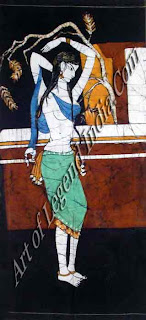 This school has many styles and
sub-styles as these paintings developed at various centres such as Basohli.
Guler. Chamba, 'Tehri, Garhwal, Nurpur, Mankot, Mandi, Kulu, Bilaspur etc.
under the patronage of their respective rulers.
This school has many styles and
sub-styles as these paintings developed at various centres such as Basohli.
Guler. Chamba, 'Tehri, Garhwal, Nurpur, Mankot, Mandi, Kulu, Bilaspur etc.
under the patronage of their respective rulers.
Krishna legend was a very
popular subject with the Pahari painters. Episodes from Krishna's life were illustrated
against the background of beautiful Pahari landscapes. Besides themes taken
from mythological legends and epics like the Ramayana, the Mahabharata, the
Bhagavao Purana, the Krishna Lila and the Gita-Govinda, some very interesting
paintings of Devi were also painted. Nayaka-Nayika themes, portraits, huntings
scenes, toilet scenes and festivals such as Holi, love stories namely Madhu
Malti and Nala - Damyanti were also frequently illustrated.
Both male and female costumes
in Pahari paintings were influenced by the fashions adopted at the Mughat court
from time to time. Nevertheless, there
were also distinctive Pahari costumes, particularly those worn by females and
they are quite visible in these paintings.
The Basohli School is the
oldest one amongst Pahari Schools in the hill area. There is no evidence of any
Pahari painting earlier than the reign of Kirpal Pal. The work of some
itinerant artist of Mughal School visiting the hill states to execute
commissions should not be confused with Pahari paintings. The distinctive style
of Basohli with its primitive vitality emerged in the last quarter of the 18th
century under Raja Kripal Pal. It is characterised by vivid and bold colours.
Faces in the early Basohli paintings are oval in shape with receding foreheads
and large expressive eyes like lotus petals.
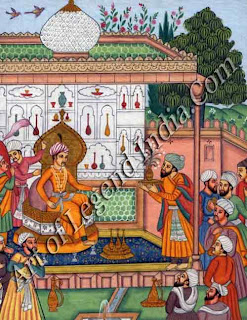 The landscape is stylised and
trees are often depicted in circular form. The composition is simple but
unique. Sometimes, a section and figures of the architecture are placed
separately into a square frame indicating a true understanding of space sense.
The Basohli Style spread over the neighbouring states remained in vogue till
the middle of the 18th century. A popular theme in Basohli painting
particularly during the reign of Kripal Pal was the Rasamanjari written by the
poet Bhanu Datta, a Maithili Brahmin, who lived in the 16th century in an area
called Tirhut in Bihar. A Basohli Rasamanjari series dated 1695 is a landmark.
It was illustrated by Devidas, a local painter of Basholi belonging to the Tarkhan
commu: nity, which produced many skilled aritsans. Amongst other styles of
Pahari painting, those of Guler and Kangra, are marked by far more naturalistic
treatment of figures and landscapes than seen in Basohli paintings. The figures
which are well-modelled and naturalistic are painted in soft and harmonious
colours. Whereas paintings of Garhwal school, developed from the Kangra style,
show an extensive use of leafless trees, the Kulu Style has folk elements with
squarish and somewhat ungainly figures.
The landscape is stylised and
trees are often depicted in circular form. The composition is simple but
unique. Sometimes, a section and figures of the architecture are placed
separately into a square frame indicating a true understanding of space sense.
The Basohli Style spread over the neighbouring states remained in vogue till
the middle of the 18th century. A popular theme in Basohli painting
particularly during the reign of Kripal Pal was the Rasamanjari written by the
poet Bhanu Datta, a Maithili Brahmin, who lived in the 16th century in an area
called Tirhut in Bihar. A Basohli Rasamanjari series dated 1695 is a landmark.
It was illustrated by Devidas, a local painter of Basholi belonging to the Tarkhan
commu: nity, which produced many skilled aritsans. Amongst other styles of
Pahari painting, those of Guler and Kangra, are marked by far more naturalistic
treatment of figures and landscapes than seen in Basohli paintings. The figures
which are well-modelled and naturalistic are painted in soft and harmonious
colours. Whereas paintings of Garhwal school, developed from the Kangra style,
show an extensive use of leafless trees, the Kulu Style has folk elements with
squarish and somewhat ungainly figures.
The Nurpur paintings are
characterised by tall women who have long limbs particularly below the waist
and are always elegantly attired. The Chamba Style is similar to that of Guler
paintings as several artists of this school came from Guler. In Mandi School,
we again find some folk elements particularly in the work done during the reign
of Raja Shamsher Singh. While Bilaspur also had a style of its own, which
extended to Sirmur, the work at Jammu was dominated by the masterly and
expressive draughtsmanship of the Nainsukh whose patron was Raja Balwant Singh
of Jammu, who is portrayed extensively in.Nainsukh paintings in all walks of
life. Nainsukh was the master-artist of Jammu school just as his elder brother
Manak was of Guier school. Both were sons of Pandit Sen of Guler. The family of
Pandit Sen is known for a number of noted artists who worked in various Pahari
states developing their own styles. After the death of Goverdhan Chand of Guler
in 1773, Manak, his two sons Kaushala and Paltu and his nephew Godhu worked at
the court of his successor Prakash Chand till circa A.D. 1785. Prakash Chand, a
great lover of arts had spent so lavishly by that time that he became a
bankrupt. Thereafter, Manak with his sons and nephew joined the court of Raja
Sansar Chand, paramount ruler of the hills, and painted there five sets of
paintings during 1785 and 1795. They are: the famous Bhagavat Purana, a
beautiful Ramayana series, a Satsai series painted as we know by Paitu, a
Ragamala now in the National Gallery of Modern Art, New Delhi and a Baramasa
in. the possession of the descendants of Sansar Chand (Lambagaon family). The
style of these sets as the work of Manak, his sons and nephew is remarkable and
these sets are amongst the greatest achievements of Pahari paintings.
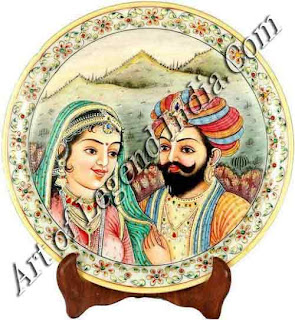
The processes and techniques
followed by the artists were almost uniform, simple and indigenous. Handmade
paper was mainly used as the base of the paintings. Thin sheets of paper, were
joined together to get the requisite thickness, on which the outline was drawn
in the light reddish brown or grey-black colour. A thin transparent white
coating was applied to the paper. Thereafter, a final drawing was made over the
white coating and then the colours were filled in. The pigments were obtained
from minerals and vegetables which were suspended in water with gum, for the
latter acted as a binding medium. Squirrel and camel hair were used in brushes.
Quite often, the painting was burnished, with glass or agate or stone from the
river Beas called 'Golla' to obtain the quality of brightness.
Writer
– Pramod Ganpatye
 The art of painting has been a
medium of both expression and communication from the earliest known period of
history. Man, as nomad, wandering in search of food and security, gradually
discovered a language of line and form for expressing his ideas; which account
for pre-historic paintings appearing in rock shelters. At a later period, this
found expression in the paintings on chalcolithic pottery discovered at various
centres. In India, the patterns were either geometric or were styled after the
flora and fauna and at times depicted human figures.
The art of painting has been a
medium of both expression and communication from the earliest known period of
history. Man, as nomad, wandering in search of food and security, gradually
discovered a language of line and form for expressing his ideas; which account
for pre-historic paintings appearing in rock shelters. At a later period, this
found expression in the paintings on chalcolithic pottery discovered at various
centres. In India, the patterns were either geometric or were styled after the
flora and fauna and at times depicted human figures.  The Jain Style is unique as it
bears an exaggerated linear quality. Facial outlines are emphasized, the nose
is long and sharp, and the eyes are shaped like petals with the farther eye
projected beyond the outline of the face. The backgrounds are illuminated in
shades of dark blue, red and green or yellow. Gold is used for decorative
purpose, especially in the manuscripts of a later era, which were done on
paper, a medium, that had replaced the palm-leaf.
The Jain Style is unique as it
bears an exaggerated linear quality. Facial outlines are emphasized, the nose
is long and sharp, and the eyes are shaped like petals with the farther eye
projected beyond the outline of the face. The backgrounds are illuminated in
shades of dark blue, red and green or yellow. Gold is used for decorative
purpose, especially in the manuscripts of a later era, which were done on
paper, a medium, that had replaced the palm-leaf. The era of Mughal painting came
to an end during the period of Shah A lam (1759-1806) when the Mughal empire
was virtually confined to an area enclosed by the walls of the Red Fort in
Delhi.
The era of Mughal painting came
to an end during the period of Shah A lam (1759-1806) when the Mughal empire
was virtually confined to an area enclosed by the walls of the Red Fort in
Delhi.  The Bijapur School of painting
was patronized and developed under the powerful king Ali Adil Shah I(1558-1580)
and his successor, Ibrahim Adil Shah I (1580-1627), a great lover of art. An
illustrated manuscript of the Nujum-ul-ulum, a book on astronomy which was
painted at Bijapur during 1580, is the most notable work of the early Bijapur
School. Prior to this, the Tarif-i-Husain Shahi manuscript was written and
illustrated at A hmadnagar during 1565-1567. The Golconda School commenced
under Ibrahim in the middle of the 17th century and continued till the period
of A bdullah Qutub Shah (1626-1672) and last Golconda ruler Tana Shah
(1672-1687). The style of this school was distinguished by rich colours,
considerable use of gold and the frequent use of unusual architectural forms.
The art of painting in the Deccan continued till late 18th century but it
became increasingly decorative. However, there are some fine sets of the
Ragamala, which were painted during 1725-1778.
The Bijapur School of painting
was patronized and developed under the powerful king Ali Adil Shah I(1558-1580)
and his successor, Ibrahim Adil Shah I (1580-1627), a great lover of art. An
illustrated manuscript of the Nujum-ul-ulum, a book on astronomy which was
painted at Bijapur during 1580, is the most notable work of the early Bijapur
School. Prior to this, the Tarif-i-Husain Shahi manuscript was written and
illustrated at A hmadnagar during 1565-1567. The Golconda School commenced
under Ibrahim in the middle of the 17th century and continued till the period
of A bdullah Qutub Shah (1626-1672) and last Golconda ruler Tana Shah
(1672-1687). The style of this school was distinguished by rich colours,
considerable use of gold and the frequent use of unusual architectural forms.
The art of painting in the Deccan continued till late 18th century but it
became increasingly decorative. However, there are some fine sets of the
Ragamala, which were painted during 1725-1778.  The rise of Vaisnavism and the
Bhakti cult in Rajasthan exercised a marked influence both on literature and
pictorial art. Krishna became the 'supreme god, while Radha was considered as
the symbol of divine love.
The rise of Vaisnavism and the
Bhakti cult in Rajasthan exercised a marked influence both on literature and
pictorial art. Krishna became the 'supreme god, while Radha was considered as
the symbol of divine love.  Marwar was an important centre
of Gujarati-Jain art activities. It was at Marwar and other places such as
Jodhpur, Pali and Nagaur that a variety of sub-schools of painting developed
during 17th-19th centuries. Of these, Jodhpur is the most important centre of
the Marwar School of painting. The turban seen in Marwar painting has its own
characteristics. It is funnel-shaped and markedly high. The faces are usually
drawn in profile, and bright colours are preferred in the composition. Spiral
clouds are also shown streaming on the horizon. A large number of portraits,
court scenes and themes such as Baramasa are to be found in the Jodhpur Style.
Though paintings at Pali, a thikana, belonging to the Marwar School are
somewhat traditional, yet they are important to the art historians for there is
a dated Ragamala series of 1623 painted by an artist Viraji, several folios of
which are now in the National Museum. In Nagaur, another centre of the Marwar
School, we find among other subjects several important portraits executed in a
markedly dignified style.
Marwar was an important centre
of Gujarati-Jain art activities. It was at Marwar and other places such as
Jodhpur, Pali and Nagaur that a variety of sub-schools of painting developed
during 17th-19th centuries. Of these, Jodhpur is the most important centre of
the Marwar School of painting. The turban seen in Marwar painting has its own
characteristics. It is funnel-shaped and markedly high. The faces are usually
drawn in profile, and bright colours are preferred in the composition. Spiral
clouds are also shown streaming on the horizon. A large number of portraits,
court scenes and themes such as Baramasa are to be found in the Jodhpur Style.
Though paintings at Pali, a thikana, belonging to the Marwar School are
somewhat traditional, yet they are important to the art historians for there is
a dated Ragamala series of 1623 painted by an artist Viraji, several folios of
which are now in the National Museum. In Nagaur, another centre of the Marwar
School, we find among other subjects several important portraits executed in a
markedly dignified style.  It was at Amber, the former
capital city of Rajasthan that the Jaipur School of painting originated. The
capital was shifted to the newly planned city of Jaipur only in 1728. The
rulers at Amber had maintained cordial relations with the Mughal emperors, and
this association left its impact on the artistic activities at Amber. Jaipur
paintings are plentiful and embrace a variety of subjects, but they neither
possess the subtler qualities as evidenced in the Bundi, Kota, Kishangarh or
Bikaner Schools nor bear the bolder qualities of Mewar and Marwar Schools of
Rajasthani painting.
It was at Amber, the former
capital city of Rajasthan that the Jaipur School of painting originated. The
capital was shifted to the newly planned city of Jaipur only in 1728. The
rulers at Amber had maintained cordial relations with the Mughal emperors, and
this association left its impact on the artistic activities at Amber. Jaipur
paintings are plentiful and embrace a variety of subjects, but they neither
possess the subtler qualities as evidenced in the Bundi, Kota, Kishangarh or
Bikaner Schools nor bear the bolder qualities of Mewar and Marwar Schools of
Rajasthani painting.  This school has many styles and
sub-styles as these paintings developed at various centres such as Basohli.
Guler. Chamba, 'Tehri, Garhwal, Nurpur, Mankot, Mandi, Kulu, Bilaspur etc.
under the patronage of their respective rulers.
This school has many styles and
sub-styles as these paintings developed at various centres such as Basohli.
Guler. Chamba, 'Tehri, Garhwal, Nurpur, Mankot, Mandi, Kulu, Bilaspur etc.
under the patronage of their respective rulers.  The landscape is stylised and
trees are often depicted in circular form. The composition is simple but
unique. Sometimes, a section and figures of the architecture are placed
separately into a square frame indicating a true understanding of space sense.
The Basohli Style spread over the neighbouring states remained in vogue till
the middle of the 18th century. A popular theme in Basohli painting
particularly during the reign of Kripal Pal was the Rasamanjari written by the
poet Bhanu Datta, a Maithili Brahmin, who lived in the 16th century in an area
called Tirhut in Bihar. A Basohli Rasamanjari series dated 1695 is a landmark.
It was illustrated by Devidas, a local painter of Basholi belonging to the Tarkhan
commu: nity, which produced many skilled aritsans. Amongst other styles of
Pahari painting, those of Guler and Kangra, are marked by far more naturalistic
treatment of figures and landscapes than seen in Basohli paintings. The figures
which are well-modelled and naturalistic are painted in soft and harmonious
colours. Whereas paintings of Garhwal school, developed from the Kangra style,
show an extensive use of leafless trees, the Kulu Style has folk elements with
squarish and somewhat ungainly figures.
The landscape is stylised and
trees are often depicted in circular form. The composition is simple but
unique. Sometimes, a section and figures of the architecture are placed
separately into a square frame indicating a true understanding of space sense.
The Basohli Style spread over the neighbouring states remained in vogue till
the middle of the 18th century. A popular theme in Basohli painting
particularly during the reign of Kripal Pal was the Rasamanjari written by the
poet Bhanu Datta, a Maithili Brahmin, who lived in the 16th century in an area
called Tirhut in Bihar. A Basohli Rasamanjari series dated 1695 is a landmark.
It was illustrated by Devidas, a local painter of Basholi belonging to the Tarkhan
commu: nity, which produced many skilled aritsans. Amongst other styles of
Pahari painting, those of Guler and Kangra, are marked by far more naturalistic
treatment of figures and landscapes than seen in Basohli paintings. The figures
which are well-modelled and naturalistic are painted in soft and harmonious
colours. Whereas paintings of Garhwal school, developed from the Kangra style,
show an extensive use of leafless trees, the Kulu Style has folk elements with
squarish and somewhat ungainly figures. 
















0 Response to "A Guide to The Indian Miniature Painting"
Post a Comment